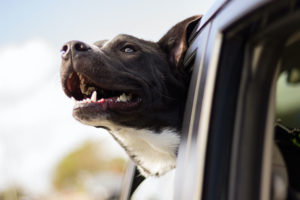Americans love their pets. Sixty-seven percent of U.S. households, or about 85 million families, own a pet, according to the 2019-2020 National Pet Owners Survey conducted by the American Pet Products Association (APPA). This is up from 56 percent of U.S. households in 1988, the first year the survey was conducted.

In a study conducted by AAA, 84% of survey respondents stated that they have driven with their pets in the car.
At the same time, our world is becoming increasingly pet-friendly. More and more people are choosing to take pets with them on day-to-day errands, on day trips, or even on family vacations. Of course, there are also occasions when pets are being transported in the family car for reasons of necessity, like trips to the veterinarian.
In a study conducted by AAA, 84% of survey respondents stated that they have driven with their pets in the car. This information suggests two important safety concerns:
- Are drivers taking appropriate safety precautions to ensure that the human passengers are safe while driving with pets in the car?
- Are drivers taking appropriate safety precautions to ensure that pets are safe in the car?
Prevent Distractions to Ensure Safety
It’s easy to envision how a driver might become distracted by allowing a pet to ride in the car. A recent survey showed that 29% of respondents admitted being distracted by their dog while driving. At the same time, respondents admitted that they had engaged in the following activities while driving, all of which increase the risk of distraction and automobile accidents:
- petting a pet while driving
- allowing a pet to sit in the driver’s lap while driving
- feeding a pet or giving a pet treats while driving, or
- playing with a pet while driving.
There are some pet distractions that may be difficult to prevent while one is operating a motor vehicle; however, an easy way to prevent many potential pet distractions while driving is this: restrain your pet in the back seat of your car! Restraining your pet inside your vehicle not only helps you to avoid distraction, but protects your pet and your other passengers in the event of a crash.
Ensure Your Pet is Safe in the Car
Only 16 percent of the respondents stated that they drove using a pet restraint when driving with a pet in the car. However, the use of a pet restraint system can meaningfully reduce the chances of an accident, and help to protect yourself, your passengers, and your pet. There are many types of pet restraint systems that can be used. A portable kennel, basket, or crate, or even a specially designed pet car seat, strapped down and placed in the rear of the vehicle is one option. Other options include barrier-style systems that are installed into the vehicle to prevent your pet from leaving their designated area. Padded pet harnesses or restraints that connect into the vehicles LATCH system or seat belt systems are also effective in not only restricting a pet’s movement, but also protecting a pet from injury in the event of a crash.
If my Pet is Injured in a Crash, Can they Make a Personal Injury Claim?
In short, no, at least not in Virginia. In Virginia, as in most states, pets are treated as personal property. In the event a pet is injured or killed in a car accident, the owner of the pet is entitled to pursue a property damage claim against the person causing the accident, in the amount of the “fair market value” of the pet, or the medical expenses incurred to treat the pet.Additionally, a pet owner cannot make a claim for emotional distress related to the loss or injury to a pet during a car accident. This is true regardless of how important the pet is to our lives, how well-trained that pet may be, how much money has been spent on training, housing and feeding the pet prior to the accident, or how much we love that pet. Under Virginia law, animals, however beloved, as personal property.
The bottom line is, some auto accidents cannot be prevented. Many, however, can, particularly when it comes to distracted driving with our pets. The most important thing you can do when traveling with your pet is to make sure that to the extent you can control or prevent a car accident, you do so. The second most important thing you can do is to make sure that when traveling, your pet is restrained in a way that minimizes his or her ability to be injured if you are in an accident.
Taking your pet in the car should be a fun and rewarding adventure for all. Following the necessary steps to prevent distracted driving and ensuring that your pet is secure in the vehicle, are two important ways that you can feel safe the next time you decide to take your pet on a drive. Just as you put on your seatbelt when you get ready to drive, you should ensure that your pet is also restrained and protected before you hit the road.
Allen & Allen is dedicated to being a resource for the community. If you or a loved one are injured through no fault of your own, contact us, we are here to help.




